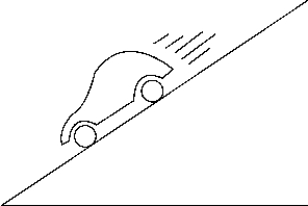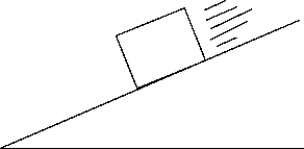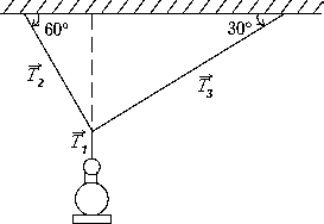A) 2.7 kg
B) 17 kg
C) 27 kg
D) 1.8 kg
E) 24 kg
G) A) and E)
Correct Answer

verified
Correct Answer
verified
Multiple Choice
 A man pushes horizontally on the book with force
A man pushes horizontally on the book with force  and moves it at constant speed along the table. Three "agents" exert forces on the book, shown as
and moves it at constant speed along the table. Three "agents" exert forces on the book, shown as  ,
,  , and
, and  in the second diagram, and three "agents" exert forces on the table, shown as
in the second diagram, and three "agents" exert forces on the table, shown as  ,
,  , and
, and  in the third diagram. The "action-reaction" forces of Newton's third law are
in the third diagram. The "action-reaction" forces of Newton's third law are
A) ![]() and
and ![]() .
.
B) ![]() and
and ![]() .
.
C) ![]() and
and ![]() .
.
D) ![]() and
and ![]() .
.
E) ![]() and
and ![]() .
.
G) A) and B)
Correct Answer

verified
Correct Answer
verified
Multiple Choice
 Which of the following free-body diagrams represents the car going downhill without acceleration?
Which of the following free-body diagrams represents the car going downhill without acceleration? 
A) 1
B) 2
C) 3
D) 4
E) 5
G) B) and E)
Correct Answer

verified
Correct Answer
verified
Multiple Choice
A body of weight w rests on the surface of Earth. What force does the body exert on Earth? (ignore Earth's rotation)
A) w
B) greater than w
C) less than w
D) 9.81w
E) zero
G) A) and B)
Correct Answer

verified
Correct Answer
verified
Multiple Choice
A force accelerates a body of mass M. A second body requires twice as much force to produce the same acceleration. What is the mass of the second body?
A) M
B) 2M
C) M/2
D) 4M
E) M/4
G) All of the above
Correct Answer

verified
Correct Answer
verified
Multiple Choice
In a crash test the strapped-in, 75-kg dummy moves a distance of 0.80 m when the test car is slammed straight into a wall at 11.2 m/s (~25 mph) . The average force acting on the dummy during the collision is how many times his own weight?
A) 0.13
B) 78
C) 0.71
D) 8.0
E) 4.0
G) D) and E)
Correct Answer

verified
Correct Answer
verified
Multiple Choice
Spiral springs A and B are identical. When a weight of 12 N is fastened to the hook on A, the hook is lowered 2 cm. If a weight of 18 N is fastened to the hook on B, that hook is lowered
A) 8 cm
B) 6 cm
C) 3 cm
D) 4 cm
E) 5 cm
G) A) and B)
Correct Answer

verified
Correct Answer
verified
Multiple Choice
Which fundamental force holds the atoms together in a block of wood?
A) gravitational force
B) electromagnetic force
C) weak nuclear force
D) strong nuclear force
E) all the four forces
G) A) and D)
Correct Answer

verified
Correct Answer
verified
Multiple Choice
Two springs with different spring constants, k1 and k2, are connected as shown in the figure below.  A force F is applied to one end. The force exerted by the wall on the spring is (take + to the right)
A force F is applied to one end. The force exerted by the wall on the spring is (take + to the right)
A) 0
B) -k1 x1
C) -k2 x2
D) F
E) -F
G) B) and C)
Correct Answer

verified
E
Correct Answer
verified
Multiple Choice
Which of the following statements is true?
A) The mass of a body is a quantitative measure of its inertia.
B) Mass is a vector quantity.
C) The mass of a body is directly proportional to the acceleration it is experiencing.
D) The unit of mass in the U.S. customary system is the newton.
E) The mass of a body is inversely proportional to the resultant force acting on it.
G) B) and E)
Correct Answer

verified
Correct Answer
verified
Multiple Choice
A horse harnessed to a wagon refuses to pull, citing Newton's third law, which states that for every force there is an equal but opposite reaction force. The horse, incorrect in its reasoning, can pull the wagon because
A) after it gives a jerk and the wagon is moving, its pulling force will be greater than the reaction to this force.
B) the law applies only to static cases.
C) the wagon cannot possibly pull back with a force equal in magnitude to the pulling force.
D) the action and reaction forces are acting on different bodies.
E) after friction is overcome, the reaction force is less than the pulling force.
G) D) and E)
Correct Answer

verified
D
Correct Answer
verified
Multiple Choice
A 15-kg block sitting on a smooth table is connected to a free-hanging 5-kg mass by a stretchless, massless cord that passes over a small frictionless pulley. The acceleration of the two-block system is
A) equal to g.
B) half of g.
C) one-third of g.
D) one-fourth of g.
E) zero.
G) A) and C)
Correct Answer

verified
Correct Answer
verified
Multiple Choice
 Which of the following free-body diagrams represents the block sliding down a frictionless inclined plane?
Which of the following free-body diagrams represents the block sliding down a frictionless inclined plane? 
A) 1
B) 2
C) 3
D) 4
E) 5
G) None of the above
Correct Answer

verified
Correct Answer
verified
Multiple Choice
The concept of a field
A) provides us with a way to understand how a body's presence is known over great distances.
B) is a useful alternative to action at a distance for explaining gravitational forces.
C) is that of space distorted by the presence of an object.
D) is useful in describing electromagnetic interactions as well as gravitational interactions.
E) is described by all of these.
G) C) and D)
Correct Answer

verified
Correct Answer
verified
Multiple Choice
If a force F is required to extend a spring by 20 cm, what force is required to extend it by 30 cm?
A) F
B) (2/3) F
C) (3/2) F
D) 600F
E) (3/5) F
G) A) and D)
Correct Answer

verified
C
Correct Answer
verified
Multiple Choice
A 6-kg block sitting on a smooth table is connected to a free-hanging 2-kg mass by a stretchless, massless cord that passes over a small frictionless pulley. The acceleration of the two-block system is
A) equal to g.
B) half of g.
C) one-third of g.
D) one-fourth of g.
E) two-thirds of g.
G) A) and E)
Correct Answer

verified
Correct Answer
verified
Multiple Choice
Which of the following is not a unit of force?
A) newton
B) pound
C) slug
D) dyne
E) kg · m/s2
G) A) and D)
Correct Answer

verified
Correct Answer
verified
Multiple Choice
A fat cat, ever conscious of its weight, walks into an elevator and steps on a scale. The elevator begins to accelerate downward. While the elevator is accelerating, the scale reads
A) more than when the elevator is stationary.
B) more than if the elevator were accelerating upward.
C) less than when the elevator is stationary.
D) a negative value.
E) Insufficient information is given to answer correctly.
G) B) and D)
Correct Answer

verified
Correct Answer
verified
Multiple Choice
You are riding an elevator that is accelerating upward at 2.20 m/s2. You have a spring balance accurately calibrated in newtons. When you hang a mass of 10.0 kg on the balance, the reading of the balance is
A) 120 N
B) 981 N
C) 76.0 N
D) 10.0 N
E) 9.81 N
G) C) and D)
Correct Answer

verified
Correct Answer
verified
Multiple Choice
A lamp with a mass m is suspended from the ceiling by two cords as shown. The ratio of the magnitude of the vertical component of the tension in  2 to that in
2 to that in  3 is
3 is 
A) 1:1
B) 1:2
C) ![]()
D) 3:2
E) 3:1
G) B) and D)
Correct Answer

verified
Correct Answer
verified
Showing 1 - 20 of 117
Related Exams